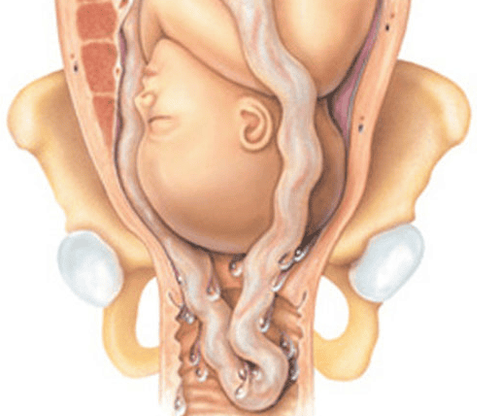This is an automatically translated article.
The article was professionally consulted by Specialist Doctor II Bui Minh Phuc - Department of Obstetrics and Gynecology - Vinmec Ha Long International Hospital. Doctor has more than 18 years working in the field of obstetrics and gynecology.Amniotomy technique is performed during normal labor, with the purpose of actively letting the amniotic fluid out to reduce amniotic pressure and shorten labor time.
1. Amniotic fluid press technique
Amniocentesis is a technique used in normal labor, when the cervix is dilated to access the amniotic fluid. The purpose of amniocentesis is to actively tear the amniotic membrane for amniotic fluid to escape, reduce amniotic pressure, and shorten labor time.Amniotomy is performed by obstetricians, nurses or midwives. There are many different ways to press amniocentesis, depending on the doctor's prescription.

Kỹ thuật bấm ối được dùng trong đẻ thường
2. Indications and contraindications
2.1 Designation
Indications for amniocentesis include:Cervical dilation 3-4cm, thick amniotic membrane, amniotic sac bulge obstructing the delivery process, cervix opens slowly, high head is difficult to penetrate; Induction of a confinement or a caesarean section or a second pregnancy in a twin birth; The placenta attaches to the side, clings to the edge of the placenta, bleeds a lot, pokes for the amniotic membrane to help pull on the placenta, so that the fetal position rests on the placenta to stop the bleeding; Amniocentesis to slowly drain out amniotic fluid in case of polyhydramnios; Amniocentesis when the cervix is fully dilated for delivery.
2.2 Contraindications
Amniotomy is contraindicated in the following cases:Not really in labor, irregular contractions; Prolapse of the placenta in the amniotic sac; The cervix is not fully dilated in the buttocks, shoulders, and face.

Trường hợp sa dây rau chống chỉ định thực hiện
3. Perform amniotomy technique
To perform amniocentesis, it is necessary to prepare a 15-20cm long needle with a barrel. The mother will be explained the effect of amniotic fluid press, lying on the delivery table in the obstetric position, not pushing, breathing evenly. The doctor will listen to the fetal heart and record the frequency and intensity of the fetal heart before performing.Amniotomy should be performed correctly. First, use sterile water to wash the pregnant woman's vagina. Then wash your hands and put on sterile gloves. Before amniocentesis, the cord should be checked to see if the cord is inside the amniotic sac. Depending on the position of the fetus, there are different ways to perform amniocentesis, including:
First position, flattened amniotic head: amniotic fluid press during uterine contractions. The doctor will stand in the middle or on the right side of the patient, two index and middle fingers will be inserted into the vagina to the amniotic membrane, the other hand will hold the needle tip and insert it into the vagina in the direction of two fingers to poke the amniotic membrane so that amniotic fluid flows out from the amniotic membrane. finger word. Finally tear the amniotic membrane wide. Head position, amniotic sac bulge: use the needle tip to poke the amniotic membrane, let the amniotic fluid flow slowly. Head the fetus towards the upper waist and then tear the amniotic membrane wide to prevent placental prolapse. Inverted position, amniotic sac bulges: in this case, it is easy to prolapse the placenta, so amniocentesis should be performed outside of uterine contractions. Let the amniotic fluid flow slowly and then tear the amniotic membrane wide. Horizontal side: only performed when indicated and qualified for internal rotation of the fetus. After amniocentesis, the amniotic membrane must be torn gradually to bring the whole hand into the uterine cavity to grasp the fetal leg for internal rotation. Amniotic fluid will help the internal rotation of the fetus easily, so in this case, amniotic fluid is kept in the uterus as much as possible. So, amniocentesis and tearing slowly, put your whole hand into the cervix to find the baby's legs and prevent the amniotic fluid from rushing out. Amniocentesis in placenta previa: the amniotic membrane must be wide open parallel to the border of the placenta after amniocentesis, to avoid tearing into the placenta causing bleeding. Amniocentesis in polyhydramnios: the mother is placed in the obstetric position with the head sloping, the buttocks slightly high. Use amniocentesis and ectopic amniocentesis. Use a needle to poke a small hole to let the amniotic fluid flow slowly when the amniotic fluid is almost finished, then tear the amniotic membrane wide. If the amniotic fluid flows out, the mother will be easily shocked because of the sudden decrease in intra-abdominal pressure and easily cause prolapse of the placenta, prolapse of the limbs or may become an abnormal position.
4. Monitoring and handling of accidents
Some complications may occur with amniocentesis technique such as:Prolapse of the placenta: check for prolapse of the placenta, prolapse of the limbs by listening to the fetal heart. If there is a prolapse of the placenta after amniotomy, the woman should lie down with her head low and raise her buttocks, using two fingers to push the placenta. If this is not possible, a cesarean section should be performed immediately. Amniotic fluid infection : occurs when a woman has a vaginal infection or has been amniotic for more than 6 hours but the pregnancy has not been delivered. Fetal puncture: the amniocentesis needle touches the fetal part, causing damage in the amniotic membrane. Posterior placenta or placenta abruption.

Nhiễm trùng ối có thể xảy trong kỹ thuật bấm ối
At Vinmec International General Hospital, there is a package maternity service as a solution to help pregnant women feel secure because of the companionship of the medical team throughout the pregnancy. When choosing Maternity Package, pregnant women can:
The pregnancy process is monitored by a team of highly qualified doctors Regular check-ups, early detection of abnormalities The package pregnancy helps to facilitate convenient for the birthing process Newborns are taken care of comprehensively. To register for examination and treatment at Vinmec International General Hospital, please book an appointment on the website for the best service.
Please dial HOTLINE for more information or register for an appointment HERE. Download MyVinmec app to make appointments faster and to manage your bookings easily.













